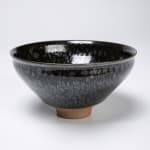Kamada Koji 鎌田幸二
H7.6 x Dia 12.7 cm
Further images
-
(View a larger image of thumbnail 1
)

-
(View a larger image of thumbnail 2
)

-
(View a larger image of thumbnail 3
)

-
(View a larger image of thumbnail 4
)

-
(View a larger image of thumbnail 5
)

-
(View a larger image of thumbnail 6
)

-
(View a larger image of thumbnail 7
)

-
(View a larger image of thumbnail 8
)

-
(View a larger image of thumbnail 9
)

-
(View a larger image of thumbnail 10
)

-
(View a larger image of thumbnail 11
)

The beautiful “Tenmoku” glaze is a historical glaze originating from the Fujian province in China during the Southern Song dynasty (10th-13th centuries). The technique was exported to Japan in the 14th century when the shōgun Ashikaga Yoshimitsu received a series of gifts from the Yongle Emperor. Following that, Japanese monks brought back the glaze technology to Japan, and it has flourished as “Tenmoku” ever since. The glaze is achieved when the piece is cooled quickly. The quicker the piece is cooled, the darker the glaze appears. The techniques of heating and cooling influence the formation of iron crystals in the final result. Kamada Koji masterfully understands the relationship between glaze, clay, and iron here, mastering the Tenmoku technique as shown in a deep black glaze that almost appears navy blue, with a nacreous sheen. Kamada adds a modern take on this functional piece by way of adding silver to the lip of the tea bowl.










